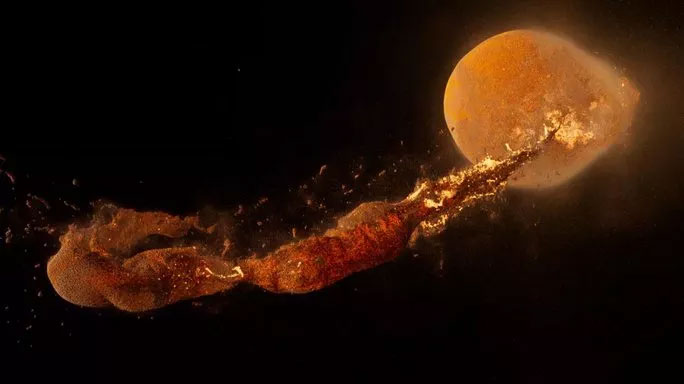A celestial body you see was born from Earth in just a few hours.
A new supercomputer simulation based on known data about Earth, the Moon and the hypothetical planet Theia has revealed a shocking piece of Earth's history.
Research just published in the scientific journal The Astrophysical Journal Letters shows that just hours after being torn apart by a violent event billions of years ago, the Earth was no longer alone.
Using the power of a supercomputer, a team led by computational cosmologist Jacob Kegerreis from Durham University in the UK showed that the Moon was formed within hours of an event that partially broke apart the Earth , which theories point to Thiea, a Mars-sized planet that collided with and merged with the primordial Earth.

The Moon formed just hours later from the rubble of Earth's torn body after a violent collision - Photo: Jacob Kegerreis
According to Live Science, the hypothesis that the Moon formed from a collision is just a hypothesis that has long been discussed by scientists, but there is little data to prove it is true, besides evidence that the materials of the Earth and the Moon have great similarities, showing that these two celestial bodies are highly likely to have once been a single body.
Using a supercomputer nicknamed COSMA, short for "cosmic machine," housed at Durham University's Distributed Advanced Research Computing (DiRAC) facility , the team simulated hundreds of ways in which the primordial Earth and Theia could collide.
Simulations of the collision from different angles, speeds and trajectories have shown how material was ejected from the collision, and how this chaotic debris coalesced over a matter of hours.
That rapid condensation, the Moon, with its primary material coming from Earth , not Theia, makes the Moon a wonderful laboratory for Earth's history.
The model also produced something that perfectly matched the known properties of the Moon: a wide, tilted orbit, a partially molten interior, a thin crust.
According to Dr Kegerreis, the discovery shows that analyzing samples from the Moon - which has changed little since its primeval days because the satellite is not as active as Earth - can help answer humanity's great question about how life on Earth originated.
- How many celestial objects are threatening the Earth?
- NASA just announced the discovery: did we find the 2nd Moon?
- More evidence of the origin of the Moon
- Discover the largest celestial object cluster in the universe
- 4 asteroids towards Earth at a speed of 50,000km / h
- Celestial Body P / 2010 A2 is just a fake star
- For the first time, identify an object from outside the Solar System
- NASA eliminated the risk of collisions between Apophis and Earth
- Comets started agricultural civilization
- Discover the most distant object in the Solar System
- The reason why China's 8.5-ton space station doesn't burn out when it falls
- Minor Pluto - The celestial body farthest from the solar system
 Van Allen's belt and evidence that the Apollo 11 mission to the Moon was myth
Van Allen's belt and evidence that the Apollo 11 mission to the Moon was myth The levels of civilization in the universe (Kardashev scale)
The levels of civilization in the universe (Kardashev scale) Today Mars, the sun and the Earth are aligned
Today Mars, the sun and the Earth are aligned The Amazon owner announced a secret plan to build a space base for thousands of people
The Amazon owner announced a secret plan to build a space base for thousands of people